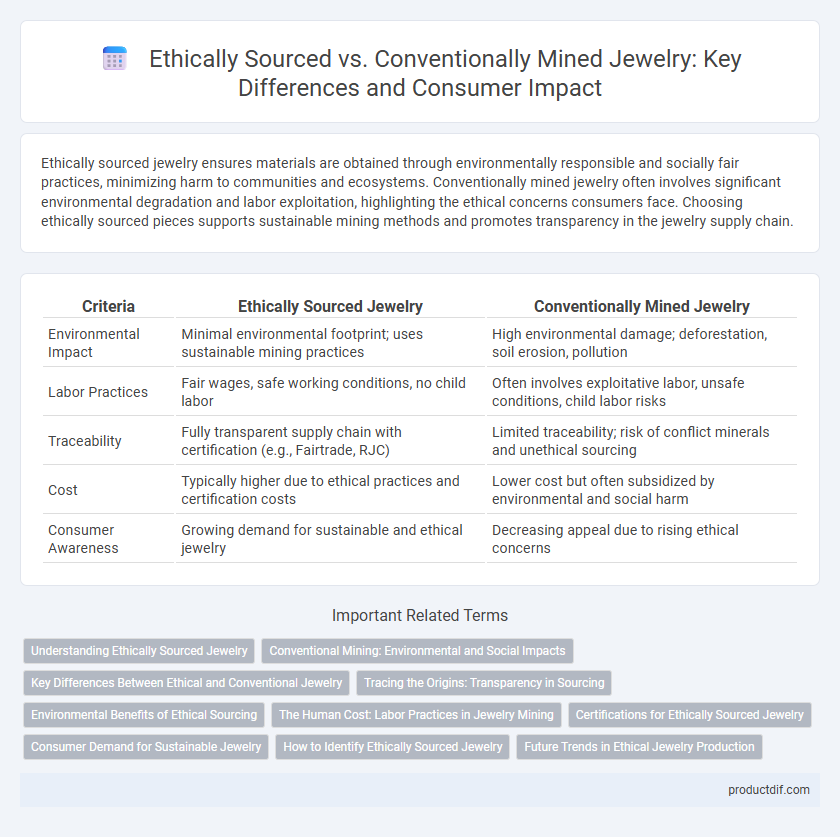Ethically sourced jewelry ensures materials are obtained through environmentally responsible and socially fair practices, minimizing harm to communities and ecosystems. Conventionally mined jewelry often involves significant environmental degradation and labor exploitation, highlighting the ethical concerns consumers face. Choosing ethically sourced pieces supports sustainable mining methods and promotes transparency in the jewelry supply chain.
Table of Comparison
| Criteria | Ethically Sourced Jewelry | Conventionally Mined Jewelry |
|---|---|---|
| Environmental Impact | Minimal environmental footprint; uses sustainable mining practices | High environmental damage; deforestation, soil erosion, pollution |
| Labor Practices | Fair wages, safe working conditions, no child labor | Often involves exploitative labor, unsafe conditions, child labor risks |
| Traceability | Fully transparent supply chain with certification (e.g., Fairtrade, RJC) | Limited traceability; risk of conflict minerals and unethical sourcing |
| Cost | Typically higher due to ethical practices and certification costs | Lower cost but often subsidized by environmental and social harm |
| Consumer Awareness | Growing demand for sustainable and ethical jewelry | Decreasing appeal due to rising ethical concerns |
Understanding Ethically Sourced Jewelry
Ethically sourced jewelry ensures gemstones and metals are obtained through responsible mining practices that prioritize environmental sustainability and fair labor conditions. This approach contrasts with conventional mining, which often involves harmful environmental impacts and exploitative labor. Consumers choosing ethically sourced jewelry support transparency, traceability, and social responsibility in the supply chain.
Conventional Mining: Environmental and Social Impacts
Conventional mining in the jewelry industry often involves extensive land disruption, habitat destruction, and significant greenhouse gas emissions, contributing to environmental degradation. This process frequently relies on harmful chemicals such as cyanide and mercury, which pollute water sources and pose health risks to nearby communities. Moreover, conventional mining operations are linked to poor labor conditions, including unsafe working environments, child labor, and exploitation in mining regions.
Key Differences Between Ethical and Conventional Jewelry
Ethically sourced jewelry is crafted from materials obtained through environmentally responsible mining practices that ensure fair wages and safe working conditions for miners. In contrast, conventionally mined jewelry often involves significant environmental degradation, exploitation of labor, and lack of transparency in supply chains. Consumers increasingly prioritize ethically sourced gems and metals for their reduced ecological impact and support of sustainable communities.
Tracing the Origins: Transparency in Sourcing
Tracing the origins of jewelry through transparent sourcing reveals significant differences between ethically sourced and conventionally mined materials, with ethical sourcing prioritizing verified supply chains and minimal environmental impact. Ethically sourced gemstones and metals often come with certifications and documentation that ensure fair labor practices and reduced ecological damage, contrasting with conventional mining's frequent lack of accountability. Transparency in sourcing enhances consumer trust and supports responsible mining initiatives, promoting sustainable industry standards.
Environmental Benefits of Ethical Sourcing
Ethically sourced jewelry significantly reduces environmental damage by minimizing habitat destruction and preventing pollution commonly associated with conventional mining methods. Sustainable practices such as responsible mining techniques and recycling precious metals lower carbon footprints and conserve natural resources. These efforts contribute to biodiversity preservation and promote long-term ecological balance in mining regions.
The Human Cost: Labor Practices in Jewelry Mining
Ethically sourced jewelry prioritizes fair labor practices, ensuring miners work in safe conditions with fair wages, while conventionally mined jewelry often involves exploitative labor, including child labor and unsafe environments. The human cost in conventional mining includes health hazards, forced labor, and lack of workers' rights, which are mitigated through responsible sourcing certifications like Fairtrade and the Responsible Jewellery Council. Consumers increasingly demand transparency and social responsibility in mining practices, pushing the industry toward ethical standards that protect mining communities.
Certifications for Ethically Sourced Jewelry
Certifications for ethically sourced jewelry, such as Fairtrade Gold and the Responsible Jewellery Council (RJC) standards, verify sustainable mining practices and fair labor conditions. These certifications ensure traceability from mine to market, minimizing environmental impact and avoiding human rights abuses common in conventionally mined jewelry. Consumers prioritizing transparency and ethical responsibility increasingly rely on certified jewelry to support sustainable sourcing and promote industry accountability.
Consumer Demand for Sustainable Jewelry
Consumer demand for sustainable jewelry is driving a significant shift from conventionally mined gemstones to ethically sourced alternatives that prioritize environmental protection and fair labor practices. Ethically sourced jewelry ensures transparency in the supply chain, reducing the environmental impact and supporting artisanal communities. This growing preference influences major brands to adopt sustainable sourcing policies, meeting the expectations of eco-conscious consumers.
How to Identify Ethically Sourced Jewelry
Ethically sourced jewelry can be identified by certifications such as Fairtrade, Responsible Jewellery Council (RJC), or Kimberley Process for diamonds, ensuring responsible mining and fair labor practices. Look for detailed product transparency, including information on the origin of metals and gemstones, and verify the seller's commitment to environmental sustainability and social responsibility. Ethical jewelers often use recycled metals and conflict-free stones, which can be confirmed through verified supply chain documentation.
Future Trends in Ethical Jewelry Production
Future trends in ethical jewelry production prioritize transparency and sustainability, with brands increasingly adopting blockchain technology to verify ethically sourced materials. Innovations in lab-grown diamonds and recycled metals reduce environmental impact compared to conventionally mined resources. Consumer demand drives industry shifts toward cruelty-free, conflict-free, and carbon-neutral practices, shaping a responsible jewelry market.
Ethically sourced vs conventionally mined Infographic

 productdif.com
productdif.com